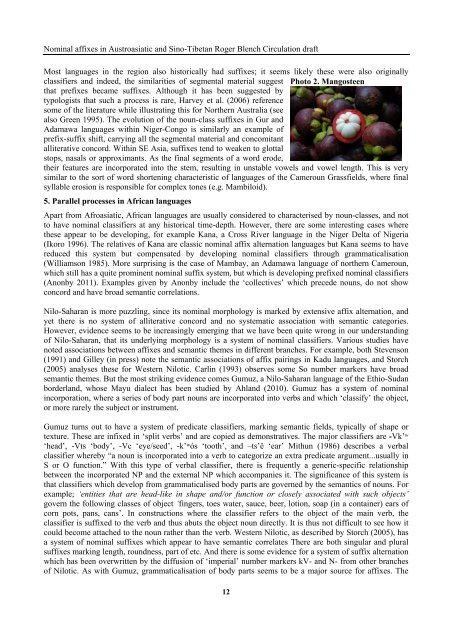The origins of nominal affixes in Austroasiatic and ... - Roger Blench
The origins of nominal affixes in Austroasiatic and ... - Roger Blench
The origins of nominal affixes in Austroasiatic and ... - Roger Blench
You also want an ePaper? Increase the reach of your titles
YUMPU automatically turns print PDFs into web optimized ePapers that Google loves.
Nom<strong>in</strong>al <strong>affixes</strong> <strong>in</strong> <strong>Austroasiatic</strong> <strong>and</strong> S<strong>in</strong>o-Tibetan <strong>Roger</strong> <strong>Blench</strong> Circulation draft<br />
Most languages <strong>in</strong> the region also historically had suffixes; it seems likely these were also orig<strong>in</strong>ally<br />
classifiers <strong>and</strong> <strong>in</strong>deed, the similarities <strong>of</strong> segmental material suggest Photo 2. Mangosteen<br />
that prefixes became suffixes. Although it has been suggested by<br />
typologists that such a process is rare, Harvey et al. (2006) reference<br />
some <strong>of</strong> the literature while illustrat<strong>in</strong>g this for Northern Australia (see<br />
also Green 1995). <strong>The</strong> evolution <strong>of</strong> the noun-class suffixes <strong>in</strong> Gur <strong>and</strong><br />
Adamawa languages with<strong>in</strong> Niger-Congo is similarly an example <strong>of</strong><br />
prefix-suffix shift, carry<strong>in</strong>g all the segmental material <strong>and</strong> concomitant<br />
alliterative concord. With<strong>in</strong> SE Asia, suffixes tend to weaken to glottal<br />
stops, nasals or approximants. As the f<strong>in</strong>al segments <strong>of</strong> a word erode,<br />
their features are <strong>in</strong>corporated <strong>in</strong>to the stem, result<strong>in</strong>g <strong>in</strong> unstable vowels <strong>and</strong> vowel length. This is very<br />
similar to the sort <strong>of</strong> word shorten<strong>in</strong>g characteristic <strong>of</strong> languages <strong>of</strong> the Cameroun Grassfields, where f<strong>in</strong>al<br />
syllable erosion is responsible for complex tones (e.g. Mambiloid).<br />
5. Parallel processes <strong>in</strong> African languages<br />
Apart from Afroasiatic, African languages are usually considered to characterised by noun-classes, <strong>and</strong> not<br />
to have <strong>nom<strong>in</strong>al</strong> classifiers at any historical time-depth. However, there are some <strong>in</strong>terest<strong>in</strong>g cases where<br />
these appear to be develop<strong>in</strong>g, for example Kana, a Cross River language <strong>in</strong> the Niger Delta <strong>of</strong> Nigeria<br />
(Ikoro 1996). <strong>The</strong> relatives <strong>of</strong> Kana are classic <strong>nom<strong>in</strong>al</strong> affix alternation languages but Kana seems to have<br />
reduced this system but compensated by develop<strong>in</strong>g <strong>nom<strong>in</strong>al</strong> classifiers through grammaticalisation<br />
(Williamson 1985). More surpris<strong>in</strong>g is the case <strong>of</strong> Mambay, an Adamawa language <strong>of</strong> northern Cameroun,<br />
which still has a quite prom<strong>in</strong>ent <strong>nom<strong>in</strong>al</strong> suffix system, but which is develop<strong>in</strong>g prefixed <strong>nom<strong>in</strong>al</strong> classifiers<br />
(Anonby 2011). Examples given by Anonby <strong>in</strong>clude the ‘collectives’ which precede nouns, do not show<br />
concord <strong>and</strong> have broad semantic correlations.<br />
Nilo-Saharan is more puzzl<strong>in</strong>g, s<strong>in</strong>ce its <strong>nom<strong>in</strong>al</strong> morphology is marked by extensive affix alternation, <strong>and</strong><br />
yet there is no system <strong>of</strong> alliterative concord <strong>and</strong> no systematic association with semantic categories.<br />
However, evidence seems to be <strong>in</strong>creas<strong>in</strong>gly emerg<strong>in</strong>g that we have been quite wrong <strong>in</strong> our underst<strong>and</strong><strong>in</strong>g<br />
<strong>of</strong> Nilo-Saharan, that its underly<strong>in</strong>g morphology is a system <strong>of</strong> <strong>nom<strong>in</strong>al</strong> classifiers. Various studies have<br />
noted associations between <strong>affixes</strong> <strong>and</strong> semantic themes <strong>in</strong> different branches. For example, both Stevenson<br />
(1991) <strong>and</strong> Gilley (<strong>in</strong> press) note the semantic associations <strong>of</strong> affix pair<strong>in</strong>gs <strong>in</strong> Kadu languages, <strong>and</strong> Storch<br />
(2005) analyses these for Western Nilotic. Carl<strong>in</strong> (1993) observes some So number markers have broad<br />
semantic themes. But the most strik<strong>in</strong>g evidence comes Gumuz, a Nilo-Saharan language <strong>of</strong> the Ethio-Sudan<br />
borderl<strong>and</strong>, whose Mayu dialect has been studied by Ahl<strong>and</strong> (2010). Gumuz has a system <strong>of</strong> <strong>nom<strong>in</strong>al</strong><br />
<strong>in</strong>corporation, where a series <strong>of</strong> body part nouns are <strong>in</strong>corporated <strong>in</strong>to verbs <strong>and</strong> which ‘classify’ the object,<br />
or more rarely the subject or <strong>in</strong>strument.<br />
Gumuz turns out to have a system <strong>of</strong> predicate classifiers, mark<strong>in</strong>g semantic fields, typically <strong>of</strong> shape or<br />
texture. <strong>The</strong>se are <strong>in</strong>fixed <strong>in</strong> ‘split verbs’ <strong>and</strong> are copied as demonstratives. <strong>The</strong> major classifiers are -Vk’ʷ<br />
‘head’, -Vts ‘body’, -Vc ‘eye/seed’, -k’ʷós ‘tooth’, <strong>and</strong> –ts’ê ‘ear’ Mithun (1986) describes a verbal<br />
classifier whereby “a noun is <strong>in</strong>corporated <strong>in</strong>to a verb to categorize an extra predicate argument...usually <strong>in</strong><br />
S or O function.” With this type <strong>of</strong> verbal classifier, there is frequently a generic-specific relationship<br />
between the <strong>in</strong>corporated NP <strong>and</strong> the external NP which accompanies it. <strong>The</strong> significance <strong>of</strong> this system is<br />
that classifiers which develop from grammaticalised body parts are governed by the semantics <strong>of</strong> nouns. For<br />
example; ‘entities that are head-like <strong>in</strong> shape <strong>and</strong>/or function or closely associated with such objects’<br />
govern the follow<strong>in</strong>g classes <strong>of</strong> object ‘f<strong>in</strong>gers, toes water, sauce, beer, lotion, soap (<strong>in</strong> a conta<strong>in</strong>er) ears <strong>of</strong><br />
corn pots, pans, cans’. In constructions where the classifier refers to the object <strong>of</strong> the ma<strong>in</strong> verb, the<br />
classifier is suffixed to the verb <strong>and</strong> thus abuts the object noun directly. It is thus not difficult to see how it<br />
could become attached to the noun rather than the verb. Western Nilotic, as described by Storch (2005), has<br />
a system <strong>of</strong> <strong>nom<strong>in</strong>al</strong> suffixes which appear to have semantic correlates <strong>The</strong>re are both s<strong>in</strong>gular <strong>and</strong> plural<br />
suffixes mark<strong>in</strong>g length, roundness, part <strong>of</strong> etc. And there is some evidence for a system <strong>of</strong> suffix alternation<br />
which has been overwritten by the diffusion <strong>of</strong> ‘imperial’ number markers kV- <strong>and</strong> N- from other branches<br />
<strong>of</strong> Nilotic. As with Gumuz, grammaticalisation <strong>of</strong> body parts seems to be a major source for <strong>affixes</strong>. <strong>The</strong><br />
12
















